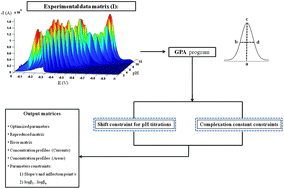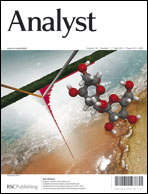Parametric Signal Fitting by Gaussian Peak Adjustment: implementation of 2D transversal constraints and its application for the determination of pKa and complexation constants by differential pulse voltammetry†
Abstract
A new method, GPA2D, is presented as a significant improvement of the previously described Gaussian Peak Adjustment (GPA) which includes, for the first time, transversal constraints to increase the consistency of the resolution along the different signals of a voltammetric dataset. The constraints deal with the evolution of peak potentials versus pH and with the implementation of chemical equilibrium constants. Moreover, pkavolt, a new tool for the pKa determination, is proposed as an example of the great versatility of the PSF-GPA (Parametric Signal Fitting by Gaussian Peak Adjustment) methodology. GPA2D and pkavolt have been successfully tested on the systems Cd(II):phytochelatin, Cu(II):


 Please wait while we load your content...
Please wait while we load your content...